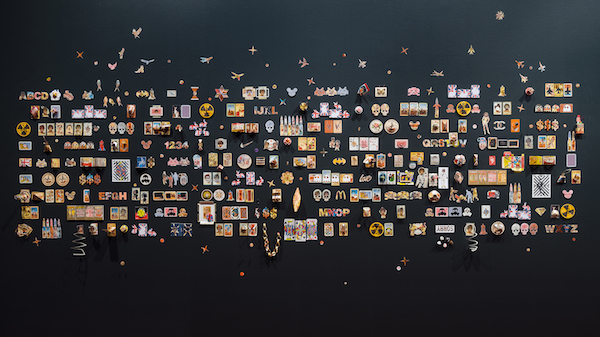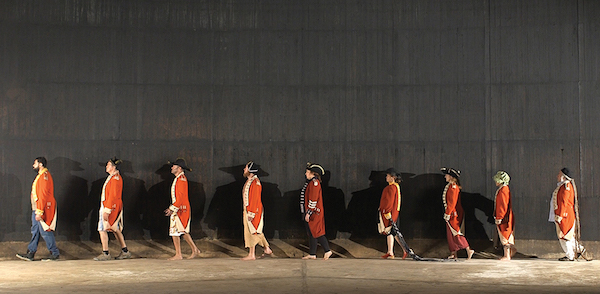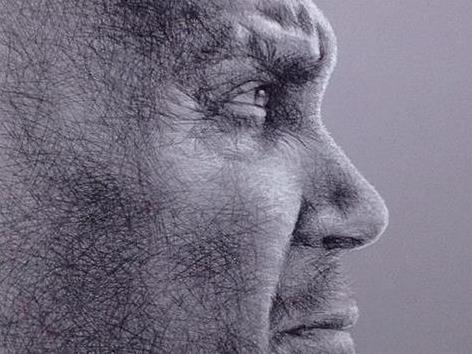Vernon Ah Kee’s portrait of Lex Wotton (2013) in the NAS exhibition “Not an animal or plant”, as part of Sydney Festival; image courtesy the artist.
Today, Friday 26 May, marks a pivotal anniversary for members of the Stolen Generations and their families. It was 20 years ago today that the landmark ‘Bringing them Home’ Report was tabled in Federal Parliament – the report of the National Inquiry into the Separation of Aboriginal and Torres Strait Islander Children from Their Families.
It coincides with another anniversary and a turning point in the modern history of Australia.
On 27 May 1967 a Federal Referendum was held. It was composed of two questions. The first was about the balance of numbers in the Senate and the House of Representatives and the second, ‘to determine whether two references in the Australian Constitution, which discriminated against Aboriginal people, should be removed.’
Fact Sheet 150 – produced by the National Archives of Australia – addresses that second question. It states:
The sections of the Constitution under scrutiny were:
51. The Parliament shall, subject to this Constitution, have power to make laws for the peace, order, and good government of the Commonwealth with respect to:-
…(xxvi) The people of any race, other than the aboriginal people in any State, for whom it is necessary to make special laws.
127. In reckoning the numbers of the people of the Commonwealth, or of a State or other part of the Commonwealth, aboriginal natives should not be counted.
The removal of the words ‘… other than the aboriginal people in any State…’ in section 51(xxvi) and the whole of section 127 were considered by many to be representative of the prevailing movement for political change within Indigenous affairs.
As a result of the political climate, this referendum saw the highest YES vote ever recorded in a Federal referendum, with 90.77 per cent voting for change.
The Constitution was subsequently changed, allowing Indigenous people to be counted in census figures and to no longer to be subjected to legal disabilities as ‘protected’ people.
Legacy has legs today
Time and again the arts have been proven to be a strong advocate for and voice on topics of social justice, racial prejudice and equality. Artists have the ability to connect with audiences at a grassroots level through storytelling, and yet can take those very personal narratives and amplify them, giving them national and international significance.
It is understandable, then, that the sector has been quick to remember these anniversaries and bring them to deeper public attention.
Rhoda Roberts AO, Head of First Nations Programming at the Sydney Opera House said: ‘It is simple – Australia is a First Nation country and Aboriginal art and culture is all about science and knowledge. I am so proud as a Widjabul to be continuing the work of my late father Frank Roberts. As a member of FACCATSI in 1967, he was instrumental in the discussions for recognition of the knowledge we hold and developing a better future. His talks flowed with the E words of economic empowerment, education and equality. And then he added the C words: “we are simple cultivators and custodians,” he would remind us.
‘Around the country from Uluru to Tasmania there are thoughtful panels, celebrations and passionate forums addressing diverse subject matters such as the intervention, deaths in custody, the Bringing them Home report and institutionalised racism evident within the current constitution,’ she continued.
‘Fifty years on my father’s words reverberate about our mother, cultivation and custodial obligation. Unless we remember the songlines that map our belonging, our responsibility for our lands and territories, and the water science and ecological knowledge then we will not be talking up country in 50 years.
‘Governments come and go, but we only have one mother and one future for us all. Let’s start listening and hearing country – our tradition bearers and wisdom keepers. Human survival will be the next big topic and unless we have the science we will all be in a fragile state,’ Roberts said.
Celebrated curator and writer, Hetti Perkins, told ArtsHub: ‘Our political fight is ultimately one to defend our culture, what makes us unique in the world.’
She continued: ‘Our artists are the voice of our people: whether an individual voice or a collective chorus, politically strident or quietly persuasive; painters, dancers, singers, filmmakers, poets or weavers, they speak for all of us in ways that honour the past, celebrate our achievements and shape our future.’
Wesley Enoch, Festival Director of Sydney Festival and a Noonuccal Nuugi man from Stradbroke Island, reflected on the significance of these anniversaries from a personal perspective.
‘My parents were married in 1967 and as I grew up we saw the changes first hand,’ he told ArtsHub. ‘Constitutional change brought about universal suffrage, more accurate census data brought about targeted policy shifts and the changes to education, health, housing and employment opportunities went hand in hand with opportunities for me and my family. Today my siblings and cousins have greater mobility and self determination than my parents and grandparents. This change is within living memory and reminds me of how Australians can co-operate for the greater good and not just self interest.’
Earlier this year, artist Vernon Ah Kee riffed off that pre-referendum classification of Aboriginal people in the title of his exhibition, Not an animal or a plant (7 January – 11 March, at NAS Gallery, Sydney). He told ArtsHub: ‘I come from far north Queensland. When I was born, I was not counted as a citizen – I was denied that human right.’
He continued: ‘I am not an error of history; this is my life.’ One of the highlights of Ah Kee’s survey exhibition was his over-scaled portraits that take on a monumentality in reasserting their civil identity.
Read review: Vernon Ah Kee: Not an animal or a plant
Exhibitions that pay tribute to First Nations
Hetti Perkins said: ‘We are the inheritors of the world’s oldest continuous cultural tradition and today our artists are internationally acclaimed. Our culture has sustained us for millennia, and against significant odds, our many and myriad cultural traditions have not only survived, they have thrived.’
Most art museums have a permanent and evolving exhibition program of their Indigenous collections, powerful art works that touch on the issues of identity, racism, displacement, country, nuclear testing, sovereignty and the Stolen Generations through a range of media, from painting on canvas and bark, to weaving and sculpture, new media, prints, photography, metalwork and glasswork.
The timing of the National Gallery of Australia’s Indigenous Art Triennial is particularly pertinent this year, opening 26 May. Tina Baum, Curator of Aboriginal and Torres Strait Islander Art at NGA captured the sentiment of the exhibition:
‘We defy:
By existing;
By determining our identity;
By asserting our histories; our culture; our language;
By telling our stories, our way;
By being one of the oldest continuous living cultures in the world.’
Defying Empire: National Indigenous Art Triennial (26 May – 10 September) surveys the contemporary practice of 30 Aboriginal and Torres Strait Islander artists from across the country – art works that mark the ongoing resilience and defiance of First Nations People against colonisation and the lack of recognition.
‘This exhibition reflects the strength, creativity, diversity and pride of contemporary Indigenous artists, highlighting the historical and ongoing activism by Indigenous people to gain equality in this country,’ said Baum.

Tony Albert, The Hand You’re Dealt, (2016). Paper (playing cards) dimensions variable, courtesy of the artist and Sullivan + Strumpf
Albert’s installation of playing cards, The Hand You’re Dealt (2016), opens up a conversation about equality in the trenches and the denied recognition of Aboriginal and Torres Strait Islander service men and women during war times.
‘Aboriginal diggers were refused entry into veteran hotels, denied the land grants that were given to white soldiers and, up until 1967, were not even considered citizens of Australia,’ said Albert. ‘Today, I stand here honoured to play a role in overturning this history of misrecognition.’
Defying Empire will be accompanied by a range of talks, lectures and workshops for the 50th Anniversary.
At the NGV Australia in Melbourne, is it a survey of artist Brooke Andrew that draws attention to contemporary conversations juxtaposed with archived histories. His exhibition The Right to Offend is Sacred (3 March – 4 June) extends challenges to the viewer – what does the title mean, and ‘sacred’ for whom?
Another Brook Andrew work, the installation The Cell, is on show at The Substation in Melbourne’s west from 26 May until 10 June.
Read review: The Right to Offend is Sacred
At 11am on Sunday 28 May, Myles Russell-Cook, Curator Indigenous Art, NGV Australia will present the free public talk, The 1967 Referendum: 50 Years On.

Travelling Bungaree, (2015). Performed by (BLAK) Douglas, Karla Dickens, Amala Groom, Warwick Keen, Peter McKenzie, Djon Mundine, Caroline Oakley, Bjorn Stewart, Leanne Tobin and Jason Wing. Developed with the assistance of Andrea James. Video: 5:46 mins. (detail)
UTS Gallery in Sydney has paid particular attention to the commemorating the anniversary of the 1967 Referendum, and the Aboriginal activism that preceded and followed this landmark event.
Living in Their Times has been curated by Djon Mundine OAM, and is presented in partnership with Jumbunna Institute. It will include a restaging of the award-winning video project Bungaree’s Farm; a project celebrating the work of Robert Campbell Jnr; and a film program curated by filmmaker Pauline Clague. This project is supported by City of Sydney.

Robert Campbell Jnr., The Fighting Sands Brothers, (1989), acrylic on canvas, 54.5 x 92 cm. Courtesy Roslyn Oxley9 Gallery.
At Deakin University, Professor Brian Martin, Deputy Director of the Institute of Koorie Education, said of the anniversary: ‘In a contemporary context it reminds us how we’ve become more conservative as a society. If we were to hold this vote now, with everything that is going on, would it be a yes vote? I’m not confident it would because, in a sense, we’ve gone backwards, and that’s why it’s vital that we’re reminded of this history.’
Martin, who is a descendant of the Muruwari, Bundjalung and Kamilaroi peoples and an artist, will presented REFERENDUM at the Wyndham Art Gallery (21 June – 30 August, VIC) – which draws on almost 28 years of portraits that he has created of people who were born before the Referendum.
That conservatism Martin speaks of is tested at the Museum of Contemporary Art Australia through the participatory performance project TRIBUNAL, which will be presented for Reconciliation Week, on 3 – 4 June at 6pm (bookings required) and as part of the MCA’s new Conversation Starters Program.
For TRIBUNAL, an Australian Truth and Reconciliation Tribunal will be created to interrogate and explore notions of truth and lies around the labels of ‘refugee’ and ‘asylum seeker’. Fusing performance with legal procedure, personal history and intimate conversations, it will be a revised version of the original performance by PYT Fairfield at Griffin Theatre in 2016.

TRIBUNAL, Rhonda Dixon as the Governor; photograph Alex Wisser
On the West Coast, the Art Gallery of Western Australia (AGWA) is presenting Plain Speak (25 February – 13 August) curated by Carly Lane. The gallery touts that everyone has a voice: ‘The Indigenous voice, the Indigenous sensibility as you’ve never encountered it before. Up close and personal.’
Artists include Vernon Ah Kee, Tony Albert, Michael Cook, Brenda L. Croft, Sandra Hill, Lesley Murray and Christopher Pease.
It is part of a ongoing commitment rolled out in 2017 including taking the AGWA Indigenous Collection online (from July 2017), the gallery’s ongoing Kimberley research project, Desert River Sea: Kimberley Art Then and Now; and Six Seasons, a major project culminating in a new permanent dedicated Indigenous Gallery, opening 29 July.
In Victoria, Bunjilaka Aboriginal Cultural Centre are presenting two exhibitions that represent significant stages in Australian history. The first is Kanalaritja at Melbourne Museum (2 June – 30 July), an exhibition that celebrates the ancient women’s practice of shell stringing by the Tasmanian Aboriginal Community. Developed by Tasmanian Museum and Art Gallery (TMAG) it is the first stop in its national tour.
The second exhibition is Ganbu Yalingbu. Ngulu-Bulok. One Day. Many Voices (27 May – 3 November) and has been curated by Stacie Piper. It is a response to the complex cultural landscape surrounding the Referendum by local Koorie artists: Hayley Millar-Baker, Arika Waulu, Nathan Patterson, Josh Muri, Mandy Nicholson, Leonie Solomon-Green, Lyn-Al Young, Judith Young and Richard Young.
Art Gallery of Ballarat are putting on Squatters and Savages, an exhibition with Ngarigo man, Peter Waples-Crowe and Megan Evans, that brings together reflections on both colonisers and Indigenous people in a creative re-imagining of colonial images in the gallery’s Collection. (27 May – 16 July).
Performance that salutes Indigenous sovereignty
A range of theatre performances, concerts and related events are being presented across Australia to mark these two significant anniversaries.
At Sydney Opera House, Deadly Voices Live commemorates the 50th anniversary of the 1967 Referendum with Deadly Voices Live, an event exploring the theme of ‘Accidental Activists’. Three influential leaders who have been driven by circumstance to apply their individual skills and passions to campaigning for political, social or cultural change – Kamilaroi man and hydrogeologist, Bradley Moggridge; Ojibwe woman Tara Houska; and activist and Frackman subject Dayne Pratzky – share their inspiring stories in a conversation hosted by Eualeyai/Kamilaroi woman Larissa Behrendt, a NSW barrister, novelist, academic and documentary film-maker. At the Playhouse, Sydney Opera House on Saturday 27 May at 4pm. Click here for ticket details.
Written by Richard Frankland MA, Conversations with the Dead revisits the tragedy of Jack, a young ambitious Koori, whose role is to look into the lives of the dead and the processes, policies and attitudes that killed them. Fusing multiple time frames, a transformative set, a live soundscape, calculated stage movement and dialogue which compellingly explores Jack’s inner conflict and the personal struggles, this modern day classic is staged by WA’s Yirra Yaakin Theatre Company at Subiaco Arts Centre until 27 May 2017. Booking details at yirrayaakin.com.au.
And at Perth’s Astor Theatre, catch a special performance by Archie Roach, together local Aboriginal performers Gina Williams, Della-Rae Morrison, Candice Lorrae, Beni Bjah and the Madjitil Moorna Choir at the Sorry Day Twentieth Anniversary Concert.
Read: How to increase First Nations performing arts programming
Another landmark Indigenous theatre production is being staged on the east coast of the country, as part of Merrigong Theatre Company’s 2017 Theatre Season. Written by two of Australia’s most respected artists, Wesley Enoch and Deborah Mailman, The 7 Stages of Grieving is a powerful play about the hope of reconciliation. This important work is an invitation to face truths, to join hands and grieve. It shares true and personal stories that need to keep being told. And perhaps most importantly, it opens a dialogue about the issues that separate and unite Indigenous and non-Indigenous people. The 7 Stages of Grieving plays at Illawarra Performing Arts Centre from 23 – 27 May. Details at merrigong.com.au.
Beginning on 26 May, Sovereign Hill in Ballarat, in regional Victoria, presents a week-long festival, Gnarrwirring Ngitj (pronounced ‘noworring nict’, a Wadawurrung phrase meaning ‘learning together’) featuring opportunities to learn traditional Wadawurrung dances as well as historical walks and a Sorry Day lecture.
For more events, including talks, film screenings and public programs vist www.reconciliation.org.au.
Festivals that throw open the doors on acceptance
Enoch told ArtsHub in an earlier interview: ‘A festival should always reflect the Artistic Director’s vision of the world, so of course for this festival it will have Indigenous content. But beyond that, a festival needs to reflect the major conversations that a nation is having, and right now the topics of First Nations recognition, sovereignty and the constitution are foremost, and coincide with the anniversary of the 1967 Australian Referendum. If we were not having those conversations in a festival format then we have a serious problem.’
Read: The soft-glove politics of Indigenous festival programming





